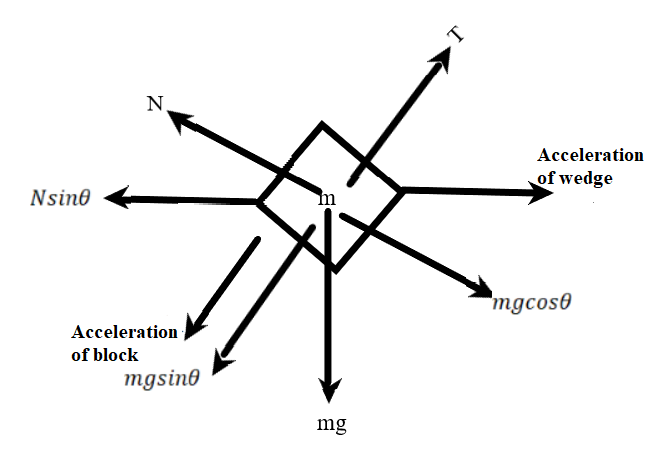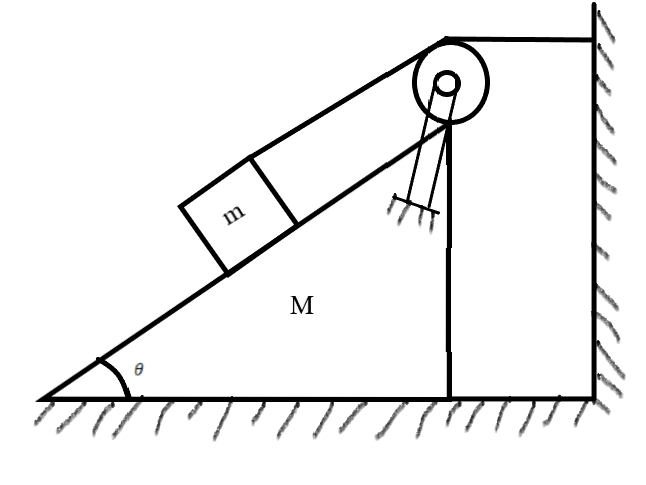
Answer
377.4k+ views
Hint: When the system is released, the block and wedge attached to the pulley start moving and their accelerations can be calculated by analyzing the forces acting on the block and the wedge from different directions. The forces acting on the block and the wedge can be studied by using Newton's second law of motion and drawing free body diagrams.
Complete step by step answer:
In the question, it is required to calculate the acceleration of the wedge, which can be found out from the various forces acting on the box and the wedge by drawing free body diagrams.
Let, the acceleration of the block be \[{a_1}\], and the acceleration of the wedge be \[{a_2}\]. The tension in the string attached to the block is \[T\], and the normal reaction on the block due to the wedge is \[N\]. When the system is released, the wedge tends to move towards the right and the block slips down. Since the length of the string does not change, so the displacement of the block and hence its acceleration will be equal to the acceleration of the wedge on the horizontal surface.
Therefore,
\[{a_1} = {a_2} = a\]
A free-body diagram of the forces acting on the block is shown in the figure below:

Now, balancing the forces acting on the block as
\[mg\sin \theta - T = m{a_1} - m{a_2}\cos \theta \]
\[ \Rightarrow mg\sin \theta - T = ma - ma\cos \theta {\text{ }}\left[ {{\text{From equation (1)}}} \right]\]
\[ \Rightarrow mg\sin \theta - T = ma\left( {1 - \cos \theta } \right)\]
\[ \Rightarrow - T = ma\left( {1 - \cos \theta } \right) - mg\sin \theta \]
\[ \Rightarrow T = mg\sin \theta - ma\left( {1 - \cos \theta } \right){\text{ }}......{\text{ (2)}}\]
Now, balancing the vertical forces as
\[mg\cos \theta - N = ma\sin \theta \]
\[ \Rightarrow - N = ma\sin \theta - mg\cos \theta \]
\[ \Rightarrow N = mg\cos \theta - ma\sin \theta {\text{ }}......{\text{ (3)}}\]
Now, balancing the forces acting in the wedge as
\[T - T\cos \theta + N\sin \theta = Ma\]
\[ \Rightarrow T\left( {(1 - \cos \theta } \right) + N\sin \theta = Ma{\text{ }}......{\text{ (4)}}\]
Substitute \[mg\sin \theta - ma\left( {1 - \cos \theta } \right)\] for \[T\], and \[mg\cos \theta - ma\sin \theta \] for \[N\]in equation (4) as
\[\left[ {mg\sin \theta - ma\left( {1 - \cos \theta } \right)} \right]\left( {(1 - \cos \theta } \right) + \left[ {mg\cos \theta - ma\sin \theta } \right]\sin \theta = Ma\]
\[ \Rightarrow mg\sin \theta - mg\sin \theta \cos \theta - ma{\left( {1 - \cos \theta } \right)^2} + mg\sin \theta \cos \theta - ma{\sin ^2}\theta = Ma\]
\[ \Rightarrow Ma = mg\sin \theta - ma{\left( {1 - \cos \theta } \right)^2} - ma{\sin ^2}\theta \]
\[ \Rightarrow Ma + ma{\left( {1 - \cos \theta } \right)^2} + ma{\sin ^2}\theta = mg\sin \theta \]
\[ \Rightarrow Ma + ma\left( {1 + {{\cos }^2}\theta - 2\cos \theta } \right) + ma{\sin ^2}\theta = mg\sin \theta \]
\[ \Rightarrow Ma + ma + ma{\cos ^2}\theta - 2ma\cos \theta + ma{\sin ^2}\theta = mg\sin \theta \]
\[ \Rightarrow Ma - 2ma\cos \theta + ma\left( {{{\sin }^2}\theta + {{\cos }^2}\theta } \right) = mg\sin \theta \]
\[ \Rightarrow Ma - 2ma\cos \theta + ma = mg\sin \theta \]
\[ \Rightarrow a\left( {M - 2m\cos \theta + m} \right) = mg\sin \theta \]
\[ \Rightarrow a = \dfrac{{mg\sin \theta }}{{\left( {M - 2m\cos \theta + m} \right)}}\]
Therefore the acceleration of the wedge is \[\dfrac{{mg\sin \theta }}{{\left( {M - 2m\cos \theta + m} \right)}}\].
Note: Whenever the motion of a body on a plane surface or inclined surface needs to be studied, it is always useful to draw a free body diagram of the various forces on the body and the directions in which they act.
Complete step by step answer:
In the question, it is required to calculate the acceleration of the wedge, which can be found out from the various forces acting on the box and the wedge by drawing free body diagrams.
Let, the acceleration of the block be \[{a_1}\], and the acceleration of the wedge be \[{a_2}\]. The tension in the string attached to the block is \[T\], and the normal reaction on the block due to the wedge is \[N\]. When the system is released, the wedge tends to move towards the right and the block slips down. Since the length of the string does not change, so the displacement of the block and hence its acceleration will be equal to the acceleration of the wedge on the horizontal surface.
Therefore,
\[{a_1} = {a_2} = a\]
A free-body diagram of the forces acting on the block is shown in the figure below:

Now, balancing the forces acting on the block as
\[mg\sin \theta - T = m{a_1} - m{a_2}\cos \theta \]
\[ \Rightarrow mg\sin \theta - T = ma - ma\cos \theta {\text{ }}\left[ {{\text{From equation (1)}}} \right]\]
\[ \Rightarrow mg\sin \theta - T = ma\left( {1 - \cos \theta } \right)\]
\[ \Rightarrow - T = ma\left( {1 - \cos \theta } \right) - mg\sin \theta \]
\[ \Rightarrow T = mg\sin \theta - ma\left( {1 - \cos \theta } \right){\text{ }}......{\text{ (2)}}\]
Now, balancing the vertical forces as
\[mg\cos \theta - N = ma\sin \theta \]
\[ \Rightarrow - N = ma\sin \theta - mg\cos \theta \]
\[ \Rightarrow N = mg\cos \theta - ma\sin \theta {\text{ }}......{\text{ (3)}}\]
Now, balancing the forces acting in the wedge as
\[T - T\cos \theta + N\sin \theta = Ma\]
\[ \Rightarrow T\left( {(1 - \cos \theta } \right) + N\sin \theta = Ma{\text{ }}......{\text{ (4)}}\]
Substitute \[mg\sin \theta - ma\left( {1 - \cos \theta } \right)\] for \[T\], and \[mg\cos \theta - ma\sin \theta \] for \[N\]in equation (4) as
\[\left[ {mg\sin \theta - ma\left( {1 - \cos \theta } \right)} \right]\left( {(1 - \cos \theta } \right) + \left[ {mg\cos \theta - ma\sin \theta } \right]\sin \theta = Ma\]
\[ \Rightarrow mg\sin \theta - mg\sin \theta \cos \theta - ma{\left( {1 - \cos \theta } \right)^2} + mg\sin \theta \cos \theta - ma{\sin ^2}\theta = Ma\]
\[ \Rightarrow Ma = mg\sin \theta - ma{\left( {1 - \cos \theta } \right)^2} - ma{\sin ^2}\theta \]
\[ \Rightarrow Ma + ma{\left( {1 - \cos \theta } \right)^2} + ma{\sin ^2}\theta = mg\sin \theta \]
\[ \Rightarrow Ma + ma\left( {1 + {{\cos }^2}\theta - 2\cos \theta } \right) + ma{\sin ^2}\theta = mg\sin \theta \]
\[ \Rightarrow Ma + ma + ma{\cos ^2}\theta - 2ma\cos \theta + ma{\sin ^2}\theta = mg\sin \theta \]
\[ \Rightarrow Ma - 2ma\cos \theta + ma\left( {{{\sin }^2}\theta + {{\cos }^2}\theta } \right) = mg\sin \theta \]
\[ \Rightarrow Ma - 2ma\cos \theta + ma = mg\sin \theta \]
\[ \Rightarrow a\left( {M - 2m\cos \theta + m} \right) = mg\sin \theta \]
\[ \Rightarrow a = \dfrac{{mg\sin \theta }}{{\left( {M - 2m\cos \theta + m} \right)}}\]
Therefore the acceleration of the wedge is \[\dfrac{{mg\sin \theta }}{{\left( {M - 2m\cos \theta + m} \right)}}\].
Note: Whenever the motion of a body on a plane surface or inclined surface needs to be studied, it is always useful to draw a free body diagram of the various forces on the body and the directions in which they act.
Recently Updated Pages
How many sigma and pi bonds are present in HCequiv class 11 chemistry CBSE

Mark and label the given geoinformation on the outline class 11 social science CBSE

When people say No pun intended what does that mea class 8 english CBSE

Name the states which share their boundary with Indias class 9 social science CBSE

Give an account of the Northern Plains of India class 9 social science CBSE

Change the following sentences into negative and interrogative class 10 english CBSE

Trending doubts
Fill the blanks with the suitable prepositions 1 The class 9 english CBSE

The Equation xxx + 2 is Satisfied when x is Equal to Class 10 Maths

In Indian rupees 1 trillion is equal to how many c class 8 maths CBSE

Which are the Top 10 Largest Countries of the World?

How do you graph the function fx 4x class 9 maths CBSE

Give 10 examples for herbs , shrubs , climbers , creepers

Difference Between Plant Cell and Animal Cell

Difference between Prokaryotic cell and Eukaryotic class 11 biology CBSE

Why is there a time difference of about 5 hours between class 10 social science CBSE




